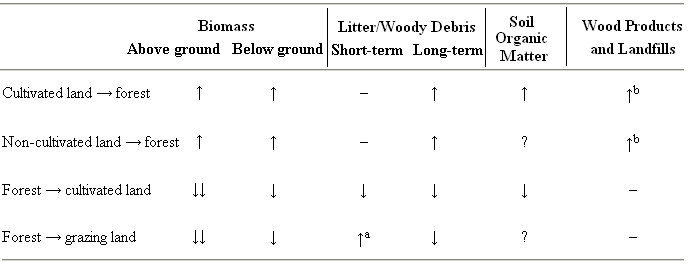3.3.2.5. Carbon Pools that Could be Considered and How They are Impacted by
ARD Activities
Section 2.2.5.3 discusses various carbon pools that could
be included in carbon accounting for the purposes of the Kyoto Protocol. This
section discusses carbon pools from the specific perspective of ARD activities.
These carbon pools are affected as follows (see Table 3-6):
- Living biomass. Aboveground (stems, branches, leaves, flowers, and
fruits) and below-ground (roots) living biomass will sequester carbon at a
rate and to a total magnitude that depends on species, climate, and site quality.
Even if forests are allowed to continue to grow, carbon stock in living biomass
will eventually reach a maximum. It takes at least decades and more commonly
centuries for forests to reach their maximum carbon storage potential. That
carbon storage potential also depends on the level of forest management and
natural disturbances. The living biomass carbon in areas where new forest
is created will increase. If below-ground living biomass is not included in
the accounting of deforestation, emissions to the atmosphere would be underreported.
In afforestation or reforestation, sequestration rates would be underreported.
- Litter and debris. Following creation of new forest, carbon in litter
and woody debris (dead organic matter) increases over time. In deforestation,
large amounts of debris are usually generated at the time of tree-felling.
Amounts remaining on the ground may be low if logging debris is burned or
removed from the site but can be substantial if debris is simply retained
on site or if trees are not felled but simply killed by chemical injection.
Amounts of litter and woody debris are usually higher in natural forest from
which little or no timber has previously been harvested than in plantations
(Ruhiyat, 1995).
- Soil. On previously cultivated land where new forest is created,
soil organic matter is expected to increase for decades to centuries (O'Connell
and Sankaran, 1997). Soil organic matter will decrease rapidly following deforestation
if land is subsequently cultivated. Changes in soil organic matter are likely
to be small if the soil is not cultivated.
- Wood products/landfills. Some ecosystem carbon removed during harvest
or deforestation may be stored in forest products and landfills rather than
immediately returning to the atmosphere.
If the harvest/regeneration cycle does not create ARD land, the proportion
of the world wood supply derived from ARD land will be very small. In the
FAO scenario, on the other hand, wood product stocks from ARD land could be
quite significant, depending on whether the harvest that precedes reforestation
is reported as a stock change. If wood products are included in carbon stock
assessments, the initial loss of carbon following harvest on the stand level
would be lower. The rate of increase in carbon stocks on ARD land also would
not diminish as fast. The long-term effect would not be very different, however,
from excluding wood products because only a portion of harvested wood usually
is stored in long-lived timber products and because share also decays with
time (Marland and Schlamadinger, 1999).
Whether any wood derived from ARD land results in a net increase in forest
product and landfill carbon pools depends on future global harvest levels
and the fate of the harvested material. In any case, it will be very difficult
to track the fate of timber harvested from ARD land and distinguish it from
all other harvested material. If (improved) wood product management is a separate
activity under Article 3.4, wood products created under ARD lands would have
to be excluded from Article 3.3 to avoid double-counting. If all wood products
from a particular ARD land were to be assigned to that land and counted under
Article 3.3, this accounting approach would be the "production approach" (IPCC,
1999). As a consequence, these wood products would have to be excluded from
the account of an importer of these products to avoid double-counting. If
the importer were to count the carbon stock change from imported wood products,
this would be the "stock change approach" (IPCC, 1999). The "atmospheric flow
approach" in IPCC (1999) is not compatible with Article 3.3 because it does
not provide a change in carbon stocks but gross flows of carbon to or from
the atmosphere.
Table 3-6: Changes in components of terrestrial
carbon stocks under different land-use changes. Note that, initially, carbon in
litter and woody debris may increase following deforestation. Aboveground biomass
and litter can also decrease (e.g., because of harvest or natural disturbances).
|

|
a It is assumed here that upon conversion of forest to grazing land, woody debris
is not, or is only partly, removed. Dead roots, in particular, would not normally
be removed. If woody debris is removed or burned, only dead roots would add to
the short-term increase of woody litter.
b If forest is subsequently harvested and used for wood production. |
|
|